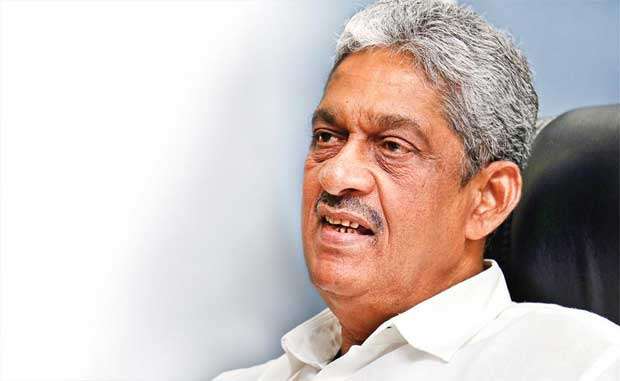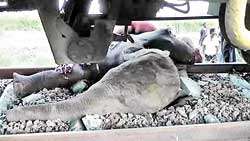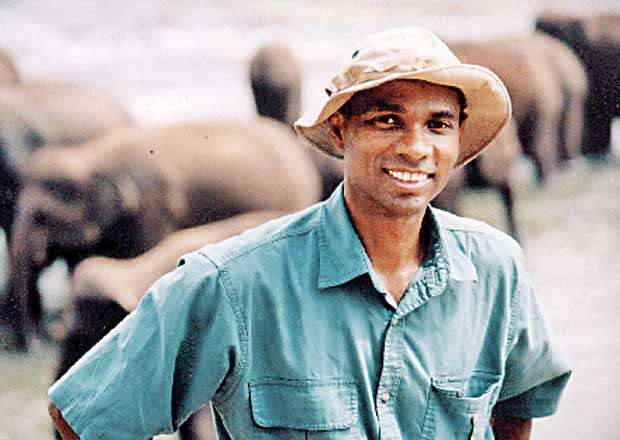Reply To:
Name - Reply Comment
Last Updated : 2024-04-25 00:00:00

A railway system which spans over a 100 years still doesn’t have the capacity to adopt new technologies to track and save elephants
 A cartoon of an elephant, stranded between the gates of the Sri Lanka Railways and the Wildlife Conservation Department done by our own staff cartoonist Gihan De Chickera very aptly describes the prevailing jumbo crisis. Within a period of three weeks, eight elephants succumbed to their injuries as a result of train collisions. Following up from the previous article titled ‘Rumble of death on the railway track’ the authorities seem to have turned a blind eye to the issue in terms of producing a solution. As mentioned in the previous article, a railway system which spans over a 100 years still doesn’t have the capacity to adopt new technologies to track and save elephants. While authorities stay put, more incidents are likely to occur resulting in the further declination of the elephant population.
A cartoon of an elephant, stranded between the gates of the Sri Lanka Railways and the Wildlife Conservation Department done by our own staff cartoonist Gihan De Chickera very aptly describes the prevailing jumbo crisis. Within a period of three weeks, eight elephants succumbed to their injuries as a result of train collisions. Following up from the previous article titled ‘Rumble of death on the railway track’ the authorities seem to have turned a blind eye to the issue in terms of producing a solution. As mentioned in the previous article, a railway system which spans over a 100 years still doesn’t have the capacity to adopt new technologies to track and save elephants. While authorities stay put, more incidents are likely to occur resulting in the further declination of the elephant population.
Given the present scenario, the Daily Mirror spoke to those responsible regarding what could be done while also shedding light on a few suggestions pointed out by experts to curb this issue in the long-run.
Speaking to the Daily Mirror Chandana Sooriyabandara, Director of the Wildlife Conservation Department said that 80 locations have been identified so far. “Out of them, 50% have been identified as critical including Habarana, Manampitiya and Welikanda. The Railway officers have inspected the place and certain structural changes need to be done,” said Sooriyabandara.

But we will have to have another round of discussions
According to Dilantha Fernando, General Manager of Sri Lanka Railways said that the place where the recent incident took place is not a usual elephant corridor. “The elephant corridor is located one and a half kilometres towards Colombo. We haven’t installed any boards since it is not a usual elephant corridor. There is an elephant fence on one side and a village on the other.
Subject minister Field Marshal Sarath Fonseka said that an advanced warning system needs to be installed. “But we will have to have another round of discussions. It may not happen immediately. Right now we don’t have a system to give any warning, but we are working on it,”said Fonseka.
In his comments regarding this issue, Dr. Prithiviraj Fernando, Chairman of the Centre for Conservation and Research (CCR), who has conducted  extensive research on wild elephants in Sri Lanka, said that an initially study has to be done regarding these locations. “Unfortunately nobody is interested. Thermal sensors could be part of the solution, but installing them without knowing the exact locations will create bigger damage. It takes some effort and money. But if done that way we can use the data to install these thermal sensors.”said Fernando.
extensive research on wild elephants in Sri Lanka, said that an initially study has to be done regarding these locations. “Unfortunately nobody is interested. Thermal sensors could be part of the solution, but installing them without knowing the exact locations will create bigger damage. It takes some effort and money. But if done that way we can use the data to install these thermal sensors.”said Fernando.
When inquired about elephant corridors, Dr. Fernando explained that elephants may use certain areas to travel on. “We need to collar elephants and find these areas. Elephants do use particular routes to travel, but they don’t use them over long distances. There are many locations such as Habarana which go through the Gal Oya reserve. Then again there’s Galgamuwa and other locations frequented by elephants. On the other hand, just because these areas are earmarked we can’t expect these accidents not to happen,”he said.
According to Dr. Fernando, putting barriers along tracks preventing elephants coming onto the track, without assessing movement patterns based on tracking data, is likely to cause the death of many more elephants. This will be due to starvation caused by loss of range, than those that die colliding with trains.

A few suggestions by Dr. Prithiviraj Fernando may help identify landscape alterations which could be done to decrease incidents :

Thermal sensors could be part of the solution, but installing them without knowing the exact locations will create bigger damage
Another possible solution includes putting up beehives, which is an eco-friendly and a sustainable method of keeping elephants away. This method was implemented after researchers observed how elephants keep away from bees.
They are not only irritated by the buzzing sound, but a group of bees could also sting on an elephant’s skin rather nastily. This method is already implemented in Africa and could be a potential income-generator for locals.

Three jumbos succumbed to their injuries when they were hit the Meenagaya Night Mail train in Namalgama, Welikanda last Saturday. The postmortem report revealed that out of the three, two were females and one was a male. Among the two female elephants, one was a pregnant female. As in the previous incident, the foetus was thrown out due to the impact of the collision.

Add comment
Comments will be edited (grammar, spelling and slang) and authorized at the discretion of Daily Mirror online. The website also has the right not to publish selected comments.
Reply To:
Name - Reply Comment
US authorities are currently reviewing the manifest of every cargo aboard MV
On March 26, a couple arriving from Thailand was arrested with 88 live animal
According to villagers from Naula-Moragolla out of 105 families 80 can afford
Is the situation in Sri Lanka so grim that locals harbour hope that they coul